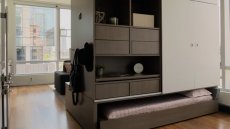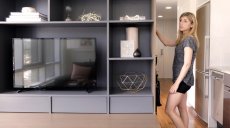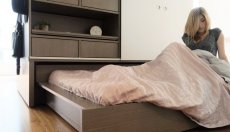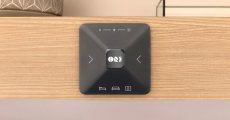Small living Spaces Furniture
 The other side houses a closet, a fold-out desk, more storage space and a bed
The other side houses a closet, a fold-out desk, more storage space and a bed
Guided by the belief that living space, particularly in cities, has become "too expensive to be static, " furniture startup Ori Systems asked itself how to fit a living room, bedroom, closet and office into a 200-300 sq ft (19-28 sq m) apartment. Its answer is shape-shifting robotic furniture.
Ori, of course, isn't the only outfit looking for a solution to this problem. Previously we've seen Italy-based Clei, produce a line of high-aesthetic modular and transformable furniture, for example, while Casa Collection is seeking to maximize the use of space with furniture units that do without moving parts.
Previously we've seen Italy-based Clei, produce a line of high-aesthetic modular and transformable furniture, for example, while Casa Collection is seeking to maximize the use of space with furniture units that do without moving parts.
Ori has spun-out from MIT's Media Lab and is partnered with designer Yves Béhar. The firm's primary aim was to create a single unit that could transform a micro studio or a one bedroom apartment into a living space with multiple different rooms, based on the changing activities of the occupant. To do so, it combined robotics, architecture and design.
The firm's primary aim was to create a single unit that could transform a micro studio or a one bedroom apartment into a living space with multiple different rooms, based on the changing activities of the occupant. To do so, it combined robotics, architecture and design.
The resulting unit is able to move back and forth on wheels at the touch of a button, without the need for tracks on the floor. A single linear actuator is attached to an adjacent wall and this pulls the unit along. This is driven by a conventional electric motor that is powered by a mains outlet. When moving, the unit is said to use only a quarter of the power of a hairdryer.
 One side of the unit houses a media center, with shelving space, storage and a bench. The other side houses a closet, a fold-out desk, more storage space and a bed that slides out from underneath the unit.
One side of the unit houses a media center, with shelving space, storage and a bench. The other side houses a closet, a fold-out desk, more storage space and a bed that slides out from underneath the unit.
A flat profile on one side means that the unit can be positioned against a wall when not in use, thereby effectively creating a larger room on the other side, which houses the media center. When moved away from a wall, the unit splits a space into two rooms.
Depending on the features of the unit that are in use, it's possible to select a preset profile for its integrated lighting. This can be done either by way of the physical interface on the unit or via an accompanying mobile app.
 Ori says that the modular robotic technology and intelligent systems that are employed could be useful in a variety of other environments where space may be at a premium, suggesting office, hospitality, retail, education and medical settings.
Ori says that the modular robotic technology and intelligent systems that are employed could be useful in a variety of other environments where space may be at a premium, suggesting office, hospitality, retail, education and medical settings.
Its first commercial residential solutions are being rolled out by building developers in a handful of US cities in the coming months, with full product availability expected from early next year. Although it is currently manufacturing its own line, Ori says collaborations with other companies are possible in the future.
Pricing info is not yet available, but Ori tells Gizmag that the robotics are relatively cheap and so the cost of a piece of furniture into which the technology is integrated will be very much down to the quality of the furniture itself.
Related posts:

 Photography by: Thomas Loof A Little Paint Goes a Long Way Ah, paint. Whether you need to conceal the mysterious marks left on the wall by the last tenants or you…
Photography by: Thomas Loof A Little Paint Goes a Long Way Ah, paint. Whether you need to conceal the mysterious marks left on the wall by the last tenants or you… A bed positioned in front of a window offers a layout solution in a bedroom with numerous doors. Some bedrooms have numerous doors to contend with when you re trying…
A bed positioned in front of a window offers a layout solution in a bedroom with numerous doors. Some bedrooms have numerous doors to contend with when you re trying… This cozied-up formal dining room is wonderful for those who have a large family or group of friends and often find themselves throwing dinner parties or hosting…
This cozied-up formal dining room is wonderful for those who have a large family or group of friends and often find themselves throwing dinner parties or hosting… The Small but Mighty Dining Room This space proves that smaller dining rooms can be just as grand as their roomier counterparts. Its most clever trick? Using a round…
The Small but Mighty Dining Room This space proves that smaller dining rooms can be just as grand as their roomier counterparts. Its most clever trick? Using a round… Clean lines, sleek surfaces, sculptural forms… There’s a lot to love about contemporary furnishings, but they can come with a serious intimidation factor—especially…
Clean lines, sleek surfaces, sculptural forms… There’s a lot to love about contemporary furnishings, but they can come with a serious intimidation factor—especially…